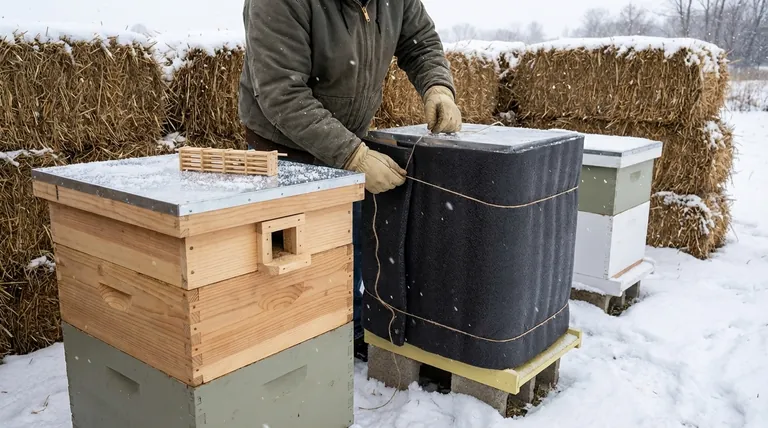Understanding your local weather is not just a suggestion for hive insulation; it is the fundamental principle upon which a successful winterization strategy is built. Knowing your region's specific temperature extremes, humidity levels, and wind patterns allows you to move beyond generic advice and tailor a defense that directly counters the most significant threats to your colony's survival.
The goal of hive insulation is not simply to make the hive warmer. It is to create a stable, dry microclimate that helps the bee cluster manage temperature and moisture efficiently, using the least amount of energy and stored honey possible.

The Key Weather Factors Driving Insulation Strategy
To effectively insulate, you must analyze how your local weather will impact the bees' internal environment. Three factors are paramount: temperature, humidity, and wind.
Analyzing Temperature Extremes
The primary job of the winter bee cluster is to generate heat by vibrating their wing muscles, keeping the queen and core of the cluster at a stable temperature.
Insulation with a sufficient R-value (a measure of thermal resistance) reduces how quickly this heat escapes the hive. In a well-insulated hive, the bees burn less honey to stay warm, increasing their chances of survival and emerging stronger in the spring.
Managing Condensation and Humidity
Cold is a threat, but moisture is the more frequent killer. A colony of bees releases a significant amount of warm, moist air through respiration.
When this warm air rises and hits a cold inner cover or lid, it condenses into water droplets. This "rain" can drip back down onto the cluster, chilling and killing the bees. Top insulation is critical for keeping the inner surface of the hive warmer than the dew point, preventing condensation from forming in the first place.
Defending Against Wind Patterns
Wind dramatically accelerates heat loss from a hive, a phenomenon known as the convective heat transfer or wind chill effect.
Even a moderately insulated hive can lose heat rapidly in a windy location. This forces the bees to consume their honey stores at a much faster rate. Using hive wraps or placing the hive behind a natural windbreak is essential in areas with persistent winter winds.
Common Pitfalls and Insulation Trade-offs
More is not always better. An improper insulation strategy can be more harmful than no insulation at all. Understanding the risks is key to making the right choice.
The Danger of Trapped Moisture
The most common mistake is insulating heavily without providing adequate ventilation. A sealed, airtight hive becomes a damp trap.
This high-humidity environment promotes mold growth and diseases like Nosema. Ventilation, typically through an upper entrance, allows moist air to escape while retaining most of the heat.
The Risk of a "False Spring"
An over-insulated hive in a sunny location can heat up rapidly on a clear winter day, fooling the bees into thinking spring has arrived.
The queen may begin laying eggs prematurely, and bees might break cluster to perform cleansing flights, only to be caught by a sudden drop in temperature when the sun disappears. This can lead to a significant loss of forager bees.
Blocking Essential Airflow
Insulation materials must never block the hive's entrances. The bees need a clear path for cleansing flights on warm days and for undertaker bees to remove the dead. Blocked entrances also cut off the hive's primary source of fresh air.
Making the Right Choice for Your Climate
Your local weather data is the blueprint for your insulation plan. Tailor your approach based on the primary challenge your bees will face.
- If your primary focus is surviving deep freezes and high winds: Prioritize wrapping the hive body with high R-value foam board and establishing a robust windbreak.
- If your primary focus is managing damp, chilly winters: Concentrate on top insulation (like a quilt box) and ensuring excellent ventilation to exhaust moisture.
- If your primary focus is navigating mild winters with occasional cold snaps: Use minimal insulation, such as a simple wrap, and ensure the hive is positioned to receive maximum winter sun.
By aligning your insulation strategy with your local weather, you move from simply hoping for survival to actively engineering your colony's success.
Summary Table:
| Weather Factor | Impact on Hive | Key Insulation Strategy |
|---|---|---|
| Temperature Extremes | Rapid heat loss from cluster | Use insulation with sufficient R-value |
| High Humidity | Condensation drips on bees, causing death | Critical top insulation to prevent "rain" |
| Strong Winds | Accelerates heat loss (wind chill) | Use hive wraps and establish a windbreak |
Equip your apiary for winter success with HONESTBEE.
As a trusted supplier for commercial apiaries and beekeeping equipment distributors, we provide the durable, high-performance insulation materials and wraps your operation needs to protect valuable colonies. Our wholesale-focused operations ensure you get the right equipment at scale.
Contact our team today for a consultation on winterizing your hives and request a wholesale catalog. Let's build a winterization strategy that works for your specific climate and scale.
Visual Guide

Related Products
- Professional Bamboo Queen Isolation Cage
- Professional Drop-Style Hive Handles for Beekeeping
- Professional Hive Front Entrance Bee Feeder
- HONESTBEE Entrance Bee Feeder Professional Hive Nutrition Solution for Beekeeping
- Professional Engraved Round Hive Number Tags for Beekeeping
People Also Ask
- What is the role of the queen cage in beekeeping? A Key Tool for Successful Queen Introduction
- When is a newly introduced queen considered accepted by the colony? The Definitive Sign You Need to See
- How should a queen cage be maintained over time? Ensure Queen Introduction Success
- What happens if a nuc does not have a laying queen after three weeks? A Beekeeper's Guide to Colony Survival
- What is sequestration, and how does it help bees reorient? A Safer Guide to Hive Relocation



















